-
PDF
- Split View
-
Views
-
Cite
Cite
Kazunari Iwasaki, Toru Tsuribe, Self-similar solutions for the dynamical condensation of a radiative gas layer, Monthly Notices of the Royal Astronomical Society, Volume 387, Issue 4, July 2008, Pages 1554–1562, https://doi.org/10.1111/j.1365-2966.2008.13294.x
Close - Share Icon Share
Abstract
A new self-similar solution describing the dynamical condensation of a radiative gas is investigated under a plane-parallel geometry. The dynamical condensation is caused by thermal instability. The solution is applicable to generic flow with a net cooling rate per unit volume and time ∝ρ2Tα, where ρ, T and α are the density, temperature and a free parameter, respectively. Given α, a family of self-similar solutions with one parameter η is found in which the central density and pressure evolve as follows: ρ(x= 0, t) ∝ (tc−t)−η/(2−α) and P(x= 0, t) ∝ (tc−t)(1−η)/(1−α), where tc is the epoch at which the central density becomes infinite. For η∼ 0 the solution describes the isochoric mode, whereas for η∼ 1 the solution describes the isobaric mode. The self-similar solutions exist in the range between the two limits; that is, for 0 < η < 1. No self-similar solution is found for α > 1. We compare the obtained self-similar solutions with the results of one-dimensional hydrodynamical simulations. In a converging flow, the results of the numerical simulations agree well with the self-similar solutions in the high-density limit. Our self-similar solutions are applicable to the formation of interstellar clouds (H i clouds and molecular clouds) by thermal instability.
1 INTRODUCTION
Thermal instability (TI) is an important physical process in astrophysical environments that are subject to radiative cooling. Fall & Rees (1985) investigated the effect of TI caused by Bremsstrahlung on structure formation at galactic and subgalactic scales. TI also plays an important role in the interstellar medium (ISM). The ISM consists of a diffuse high-temperature phase (warm neutral medium, or WNM) and a clumpy low-temperature phase (cold neutral medium, or CNM) in supersonic turbulence. It is known that the ISM is thermally unstable in the temperature range between these two stable phases; that is, in the range T∼ 300 − 6000 K (Dalgarno & McCray 1972). Koyama & Inutsuka (2000,2002) suggested that the structure of the ISM is provided by the phase transition that is caused by the TI that occurs in a shock-compressed region.
The basic properties of TI were investigated by Field (1965), who investigated the TI of a spatially uniform gas using linear analysis for the unperturbed state in thermal equilibrium. The net cooling function per unit volume and time was assumed to be Λ0ρ2Tα−Γ0ρ. Field (1965) showed that gas is isobarically unstable for α < 1 and is isochorically unstable for α < 0. In thermal non-equilibrium, however, where the heating and the cooling rates are not equal in the unperturbed state, the stability condition of TI is different from that in thermal equilibrium. This situation is, for example, generated in a shock-compressed region. Balbus (1986) derived a general criterion for the TI of gas in a non-equilibrium state. A flow dominated by cooling is isobarically unstable for α≲ 2 and is also isochorically unstable for α≲ 1. Therefore, the phase with T∼ 300 − 6000 K is both isobarically and isochorically unstable.
The non-linear evolution of TI has been investigated by many authors (Koyama & Inutsuka 2002; Audit & Hennebelle 2005; Hennebelle & Audit 2007; Heitsch et al. 2006; Vazquez-Semadeni et al. 2007) using multi-dimensional simulations. However, the non-linear behaviour has only been investigated analytically by a few authors, using some simplifications in an attempt to gain a deeper insight into the nature of TI. Meerson (1989) investigated analytic solutions under the isobaric approximation. However, this approximation is valid only in the limit of short or intermediate scales.
In this paper, a new semi-analytic model for the non-linear hydrodynamical evolution of TI for a thermally non-equilibrium gas is considered without the isobaric approximation. Once TI occurs, the density increases dramatically until a thermally stable phase is reached. During this dynamical condensation, the gas is expected to lose its memory of the initial conditions, and is expected to behave in a self-similar manner (Zel'dovich & Raizer 1967; Landau & Lifshitz 1959). In particular, in star formation, self-similar (S-S) solutions for a runaway collapse of a self-gravitating gas have been investigated by many authors (Penston 1969; Larson 1969; Shu 1977; Hunter 1977; Whitworth & Summers 1985; Boily & Lynden-Bell 1995). In this paper, S-S solutions describing dynamical condensation by TI are investigated by assuming a simple cooling rate without self-gravity. A family of S-S solutions that have two asymptotic limits (the isobaric and the isochoric modes) is presented.
In Section 2, we derive the S-S equations, and describe the mathematical characteristics of our S-S equations as well as the numerical methods. In Section 3, our S-S solutions are presented and their properties are discussed. In Section 4, the S-S solutions are compared with the results of one-dimensional numerical simulations. The astrophysical implications of the S-S solutions and the effect of dissipation are also discussed. Our study is summarized in Section 5.
2 FORMULATION
2.1 Basic equations
In this paper, we consider S-S solutions describing runaway condensation in a region where the cooling rate dominates the heating rate. The S-S solutions describe the evolution of the fluid after its memories of initial and boundary conditions have been lost during the runaway condensation. Therefore, the solutions are independent of how a cooling-dominated region forms.
 is considered, where Λ and Γ are the cooling and heating rates per unit volume and time, respectively. In low-density regions, the main cooling process is spontaneous emission by collisionally excited gases. In this situation, the cooling rate is determined by the collision rate, which is proportional to ρ2. Therefore, we adopt the following formula as the net cooling rate:
is considered, where Λ and Γ are the cooling and heating rates per unit volume and time, respectively. In low-density regions, the main cooling process is spontaneous emission by collisionally excited gases. In this situation, the cooling rate is determined by the collision rate, which is proportional to ρ2. Therefore, we adopt the following formula as the net cooling rate: 



2.2 Derivation of self-similar equations







2.3 Homologous special solutions






2.4 Asymptotic behaviour
In this subsection, the asymptotic behaviour of the S-S solutions at ξ→∞ and ξ→ 0 is investigated.
2.4.1 Solutions forξ→∞







2.4.2 Solutions forξ→ 0






2.5 Critical point







2.5.1 Topological properties of the critical point





2.6 Numerical methods

The critical point is specified by (ξs, Vs) because there are four unknown quantities Qs and two conditions, namely equations (36). Moreover, the similarity equations (42) are invariant under the transformation ξ→mξ, V →mV, Ω→m−2(α−1)Ω and X→mX, where m is an arbitrary constant. Therefore, the S-S solution for (mξs, mVs) is the same as that for (ξs, Vs). As one can take m in such a way that (ξs, Vs) satisfies the relation ξ2s+V2s= 1, the critical point is specified only by ξs.
Given ξs, the velocity is obtained as  . From equations (36), Ωs and Xs are determined. As Xs=Vs+ξs is positive, the range of ξs is
. From equations (36), Ωs and Xs are determined. As Xs=Vs+ξs is positive, the range of ξs is  . The similarity equations (42) are integrated from ξs in both directions (ξ→ 0 and ξ→∞) along the gradient derived from equation (38) using the fourth-order Runge–Kutta method. The position of the critical point ξs is determined iteratively by the bisection method until the solution satisfies the asymptotic behaviours (see Subsection 2.4).
. The similarity equations (42) are integrated from ξs in both directions (ξ→ 0 and ξ→∞) along the gradient derived from equation (38) using the fourth-order Runge–Kutta method. The position of the critical point ξs is determined iteratively by the bisection method until the solution satisfies the asymptotic behaviours (see Subsection 2.4).
3 RESULTS
3.1 Physically possible range of parameters (η, α)
In this section, we constrain the parameter space (η, α) by the physical properties of the flow.
3.1.1 Range ofη








3.1.2 The range ofα
In the similarity equations (42), the critical point is specified by ξs for given α and η. The topology of the critical point is given by the two eigenvalues of the eigenequation (39) other than λ= 0. When the two eigenvalues are real and have the same sign, the critical point is a node. When the two eigenvalues are real and have opposite signs, the critical point is a saddle. When the two eigenvalues are complex, the critical point is a spiral. Fig. 1 shows the topology of the critical point in the parameter space (ξs, η) for α= 0.3, 0.5, 0.8, 0.9, 1.1 and 1.2. In Fig. 1, the letters ‘N’, ‘SD’ and ‘SP’ indicate a node, a saddle and a spiral, respectively. The open circles indicate the numerically obtained S-S solutions presented in Subsection 3.2. Fig. 1 shows that the topology drastically changes at α= 1. For α < 1, because the critical point is a node or a saddle, the S-S solutions are expected to exist. For α≃ 1.1, a non-negligible fraction of the parameter space is covered by a spiral. Almost all the parameter space is a spiral for α≳ 1.2. We searched the S-S solutions that connect 0 < ξ < ∞ and found them only in N and SD for α < 1.
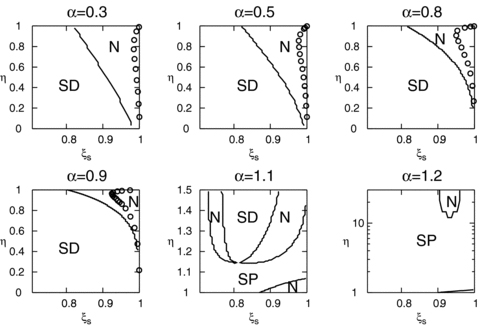
Topological properties of the critical point for α= 0.3, 0.5, 0.8, 0.9, 1.1 and 1.2. The ordinates and abscissas are η and ξs, respectively. The letters ‘N’, ‘SD’ and ‘SP’ indicate a node, a saddle and a spiral, respectively. The open circles indicate S-S solutions.
3.2 Self-similar solutions
In this subsection, we describe new S-S solutions and investigate their properties. As shown in Subsection 3.1.1, our S-S solutions exist for 0 < η < 1 and α < 1.
Figs 2(a),(b) and (c) show the obtained S-S solutions for α= 0.5 with η= 0.98, 0.76 and 0.12, respectively. The ordinates denote the dimensionless quantities (Ω, −V, Π, X). The abscissas denote the dimensionless coordinate ξ. The S-S solutions for η= 0.98 and 0.12 approximately represent the isobaric and the isochoric modes, respectively. The solution for η= 0.76 ∼ηeq corresponds to the intermediate mode shown in Subsection 3.1.1. The open circles indicate the critical points. In Figs 2(a),(b) and (c), one can see that the S-S solutions depend strongly on η. Let us focus on the dependence on η of the density and pressure, shown in Figs 2(d) and (e), respectively. In these figures, it can be seen that, for η= 0.98 (the isobaric mode), the density increases sharply towards ξ= 0, whereas the pressure is almost spatially constant. In contrast, for η= 0.12 (the isochoric mode), the density is almost spatially constant whereas the pressure decreases sharply towards ξ= 0.
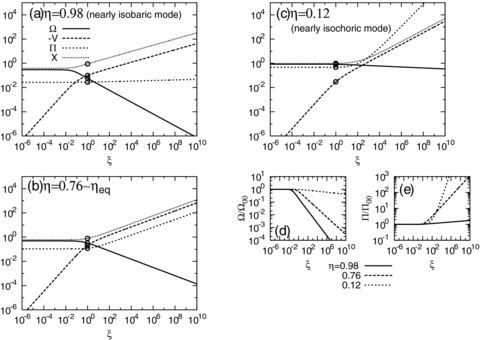
The distribution of dimensionless quantities (Ω, −V, Π, X) for (a) η= 0.98, (b) 0.76 and (c) 0.12. The open circles indicate the critical points. Panels (d) and (e) indicate the dependence of Ω/Ω00 and Π/Π00, respectively, on η.
Next, the S-S solutions are shown using the dimensional physical quantities for various values of η. Fig. 3 shows the time evolution of ρ (first row), P (second row) and −v (third row). The columns in Fig. 3 correspond to η= 0.98, 0.76 and 0.12 from left to right. The solid, long-dashed, short-dashed and dotted lines correspond to t*= 1, 0.1, 0.01 and 0.001, respectively. From Fig. 3, it can clearly be seen that η specifies how the gas condenses. In the case with η= 0.98 (the isobaric mode), runaway condensation occurs and the density increases in the central region, whereas the pressure is spatially and temporally constant. In the case with η= 0.12 (the isochoric mode), the density is spatially and temporally constant and P00 decreases considerably. In the case with η= 0.76, the condensation occurs in an intermediate manner between the isobaric and the isochoric modes.
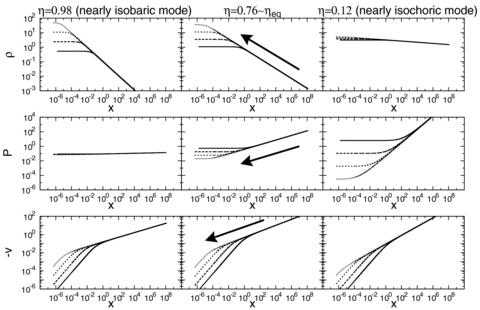
Time evolution of dimensional quantities (ρ, P, −v). The solid, long-dashed, short-dashed and dotted lines correspond to t*= 1, 0.1, 0.01 and 0.001, respectively. The columns correspond to η= 0.98, 0.76 and 0.12 from left to right, respectively. The arrows indicate the time evolution of flow.
The relevant parameters (η, n, −η/(2 −α), (1 −η)/(1 −α), ξs, Ω00, X00, Ω∞, V∞, X∞) for the S-S solutions obtained for α= 0.5 are summarized in Table 1.
| η | n | −η/(2 −α) | (1 −η)/(1 −α) | ξs | Ω00 | X00 | Ω∞ | V∞ | X∞ |
| 0.059 | 1.923 | −0.039 | 1.882 | 0.9999 | 0.873 | 0.977 | 0.882 | −0.0234 | 0.0408 |
| 0.272 | 1.818 | −0.181 | 1.455 | 0.9975 | 0.768 | 0.883 | 0.782 | −0.124 | 0.201 |
| 0.500 | 1.667 | −0.333 | 1.000 | 0.9907 | 0.643 | 0.766 | 0.612 | −0.244 | 0.391 |
| 0.761 | 1.493 | −0.507 | 0.615 | 0.9792 | 0.486 | 0.609 | 0.343 | −0.333 | 0.613 |
| 0.945 | 1.370 | −0.631 | 0.110 | 0.9853 | 0.360 | 0.472 | 0.123 | −0.223 | 0.805 |
| 0.995 | 1.337 | −0.663 | 0.011 | 0.9986 | 0.237 | 0.315 | 0.0260 | −0.0576 | 0.952 |
| η | n | −η/(2 −α) | (1 −η)/(1 −α) | ξs | Ω00 | X00 | Ω∞ | V∞ | X∞ |
| 0.059 | 1.923 | −0.039 | 1.882 | 0.9999 | 0.873 | 0.977 | 0.882 | −0.0234 | 0.0408 |
| 0.272 | 1.818 | −0.181 | 1.455 | 0.9975 | 0.768 | 0.883 | 0.782 | −0.124 | 0.201 |
| 0.500 | 1.667 | −0.333 | 1.000 | 0.9907 | 0.643 | 0.766 | 0.612 | −0.244 | 0.391 |
| 0.761 | 1.493 | −0.507 | 0.615 | 0.9792 | 0.486 | 0.609 | 0.343 | −0.333 | 0.613 |
| 0.945 | 1.370 | −0.631 | 0.110 | 0.9853 | 0.360 | 0.472 | 0.123 | −0.223 | 0.805 |
| 0.995 | 1.337 | −0.663 | 0.011 | 0.9986 | 0.237 | 0.315 | 0.0260 | −0.0576 | 0.952 |
| η | n | −η/(2 −α) | (1 −η)/(1 −α) | ξs | Ω00 | X00 | Ω∞ | V∞ | X∞ |
| 0.059 | 1.923 | −0.039 | 1.882 | 0.9999 | 0.873 | 0.977 | 0.882 | −0.0234 | 0.0408 |
| 0.272 | 1.818 | −0.181 | 1.455 | 0.9975 | 0.768 | 0.883 | 0.782 | −0.124 | 0.201 |
| 0.500 | 1.667 | −0.333 | 1.000 | 0.9907 | 0.643 | 0.766 | 0.612 | −0.244 | 0.391 |
| 0.761 | 1.493 | −0.507 | 0.615 | 0.9792 | 0.486 | 0.609 | 0.343 | −0.333 | 0.613 |
| 0.945 | 1.370 | −0.631 | 0.110 | 0.9853 | 0.360 | 0.472 | 0.123 | −0.223 | 0.805 |
| 0.995 | 1.337 | −0.663 | 0.011 | 0.9986 | 0.237 | 0.315 | 0.0260 | −0.0576 | 0.952 |
| η | n | −η/(2 −α) | (1 −η)/(1 −α) | ξs | Ω00 | X00 | Ω∞ | V∞ | X∞ |
| 0.059 | 1.923 | −0.039 | 1.882 | 0.9999 | 0.873 | 0.977 | 0.882 | −0.0234 | 0.0408 |
| 0.272 | 1.818 | −0.181 | 1.455 | 0.9975 | 0.768 | 0.883 | 0.782 | −0.124 | 0.201 |
| 0.500 | 1.667 | −0.333 | 1.000 | 0.9907 | 0.643 | 0.766 | 0.612 | −0.244 | 0.391 |
| 0.761 | 1.493 | −0.507 | 0.615 | 0.9792 | 0.486 | 0.609 | 0.343 | −0.333 | 0.613 |
| 0.945 | 1.370 | −0.631 | 0.110 | 0.9853 | 0.360 | 0.472 | 0.123 | −0.223 | 0.805 |
| 0.995 | 1.337 | −0.663 | 0.011 | 0.9986 | 0.237 | 0.315 | 0.0260 | −0.0576 | 0.952 |




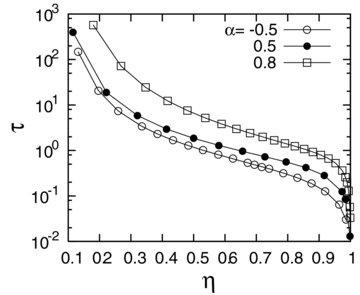
The dependence of τ (equation 54) on η. The open circles, filled circles and open boxes indicate the S-S solutions for α=−0.5, 0.5 and 0.8, respectively.
Finally, we consider the range of α for which the S-S solutions exist. When α= 1.0, no S-S solutions are found except for the homologous special solutions (see Subsection 2.3). Moreover, as mentioned in Subsection 2.3, there are no homologous isochoric solutions for α > 1. Therefore, for α > 1, the condensation of the fluid is not expected to be self-similar. Fouxon et al. (2007) found a family of exact solutions for α= 1.5 > 1. Their solutions are not self-similar because tcensound and tcencool in the central region obey the following different scaling laws: tcensound∝t3/2* and tcencool∝t*. In their solution, during condensation, as tcensound becomes much smaller than tcencool, the pressure of the central region is expected to be constant and the isobaric approximation is locally valid.
4 DISCUSSION
4.1 Comparison with the results of time-dependent numerical hydrodynamics
We compare the S-S solutions with the results of time-dependent numerical hydrodynamics using the one-dimensional Lagrangian second-order Godunov method (van Leer 1997). A converging flow of an initially uniform and thermal-equilibrium gas (ρ(x) =P(x) = 1) is considered. An initial velocity field is given by v(x) =−2 tanh(x/L), where L is a parameter. The net cooling rate is assumed to be  , where α= 0.5. The inflow creates two shock waves, which propagate outwards. Runaway condensation of the perturbation owing to TI occurs in the post-shock region because the cooling rate dominates the heating rate. The central density continues to grow and ultimately becomes infinite. During the runaway condensation, the flow in the central region is expected to lose the memory of the initial and the boundary conditions, and to converge to one of the S-S solutions. The scale of perturbation in the post-shock region can be controlled by the value of L. The larger L is, the larger the scale of perturbation becomes. We perform numerical simulations for L= 0.005, 0.01, 0.02, 0.2 and 0.5.
, where α= 0.5. The inflow creates two shock waves, which propagate outwards. Runaway condensation of the perturbation owing to TI occurs in the post-shock region because the cooling rate dominates the heating rate. The central density continues to grow and ultimately becomes infinite. During the runaway condensation, the flow in the central region is expected to lose the memory of the initial and the boundary conditions, and to converge to one of the S-S solutions. The scale of perturbation in the post-shock region can be controlled by the value of L. The larger L is, the larger the scale of perturbation becomes. We perform numerical simulations for L= 0.005, 0.01, 0.02, 0.2 and 0.5.
Fig. 5 shows the time evolution of ρcen(t) and Pcen(t) as a function of 1 −t/tcon, where ρcen and Pcen are the central density and pressure, and tcon is the epoch at which ρcen becomes infinite as estimated from the numerical results. The panels represent (a) L= 0.01, (b) 0.02, (c) 0.2 and (d) 0.5. Using equation (43), the time evolution of ρcen(t) and Pcen(t) of each simulation provides the corresponding η. As a result, the corresponding values of η are found to be (a) 0.99, (b) 0.98, (c) 0.76 and (d) 0.50. The thin solid lines in Fig. 5 indicate the corresponding S-S solutions. From the value of η and Fig. 5, cases (a) and (b) correspond to the isobaric mode, case (c) corresponds to the intermediate mode (η∼ηeq), and case (d) corresponds to the isochoric mode. There is a difference in the convergence speed from the corresponding S-S solution. Fig. 5 shows that the convergence speed of (a) and (b) is faster than that of (c) and (d). This is because the scale-length of the condensed region of (a) and (b) is smaller and the sound-crossing time-scale is shorter.
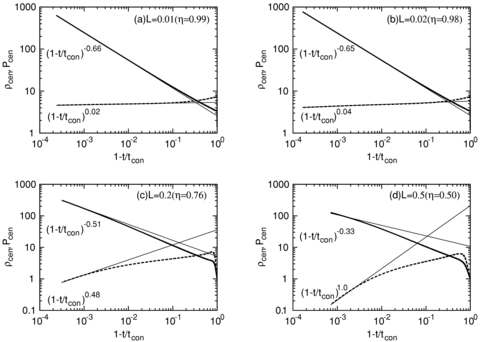
The time evolution of ρ00 (thick lines) and P00 (dashed lines) as a function of 1 −t/tcon for (a) L= 0.01, (b) 0.02, (c) 0.2 and (d) 0.5. The thin solid lines indicate the corresponding S-S solutions.
Fig. 6 shows the time evolution of the rescaled density ρ(1 −t/tcon)η/(2−α) and pressure P(1 −t/tcon)−(1−η)/(1−α) as a function of the rescaled coordinate x(1 −t/tcon)−n. The parameters L and η in Fig. 6 are the same as those in Fig. 5. The thin solid lines in Fig. 6 indicate the corresponding S-S solutions. In all cases (a–d), the central regions are well approximated by the corresponding S-S solutions. From Fig. 6, it can be seen that the region that is well approximated by the S-S solution spreads with time in each panel.
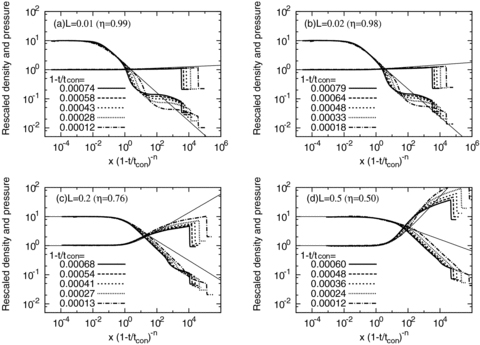
The distribution of the rescaled density ρ(1 −t/tcon)η/(2−α) and pressure P(1 −t/tcon)−(1−η)/(2−α) as a function of the scaled coordinate x(1 −t/tcon)−n. The L and η in each panel are the same as those in Fig. 5. The lines are labelled according to 1 −t/tcon. The rescaled density and pressure at the centre are set to 10 and 0.1, respectively. The thin solid lines indicate the corresponding S-S solutions.
From the above discussion, the non-linear evolution of perturbation is well approximated by one of the S-S solutions in the high-density limit. Which S-S solution (0 < η < 1) is more likely to be realized in actual environments where various scale perturbations exist? To answer this question, the dependence of tcon on L is investigated. Fig. 7 shows the dependence of 1/tcon on 1/L. Here, 1/L and 1/tcon correspond to the wavenumber and the growth rate of the perturbation, respectively. Therefore, Fig. 7 can be interpreted as an approximate dispersion relation for the non-linear evolution of TI. For larger 1/L, 1/tcon is larger, and 1/tcon appears to approach a certain asymptotic value. A similar behaviour is also found in the dispersion relation of Field (1965) without heat conduction. In Fig. 7, the condensation for 1/L= 5.0 corresponds to the intermediate mode. Furthermore, although the isobaric condensation grows faster, there is little difference between 1/tcon for 1/L= 200 (the isobaric mode) and 2 (the isochoric mode). Therefore, both the isobaric and the isochoric condensations are expected to coexist in actual astrophysical environments.
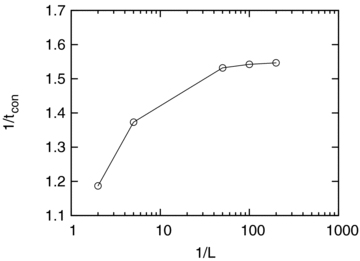
The dependence of the growth rate, 1/tcon, on the wavenumber, 1/L.
4.2 Astrophysical implications
In astrophysical environments, there are roughly two ranges of temperature with α < 1 where our S-S solutions are applicable.

In the low-temperature case, 300 ≲T≲ 6000 K, the dominant coolant is neutral carbon atom. Koyama & Inutsuka (2000) suggested that the structure of the ISM is caused by TI during the phase transition (WNM → CNM). The phase transition is induced by a shock wave. Hennebelle & Perault (1999) considered the converging flow of a WNM under a plane-parallel geometry using one-dimensional hydrodynamical calculations, and investigated the condensation condition of the Mach number and pressure in the pre-shock region. In situations that satisfy their condition, S-S condensation is expected to occur.
4.3 Effects of dissipation




 (Parker 1953) and the following cooling function (Koyama & Inutsuka 2002):
(Parker 1953) and the following cooling function (Koyama & Inutsuka 2002): 



 , in the high-temperature case the S-S solution with τ≳ 0.1 is expected to describe the dynamical condensation well.
, in the high-temperature case the S-S solution with τ≳ 0.1 is expected to describe the dynamical condensation well.As the temperature decreases,  decreases and becomes less than unity at a certain epoch. Thereafter, our S-S solutions are invalid and the effect of dissipation becomes important.
decreases and becomes less than unity at a certain epoch. Thereafter, our S-S solutions are invalid and the effect of dissipation becomes important.
5 SUMMARY
We have provided S-S solutions describing the dynamical condensation of a radiative gas with Λ−Γ∼ρ2Tα. The results of our investigation are summarized as follows.
Given α, a family of S-S solutions written as equation (8) is found. The S-S solutions have the following two limits. The gas condenses almost isobarically for η∼ 1, and the gas condenses almost isochorically for η∼ 0. The S-S solutions exist for all values of η between the two limits (0 < η < 1). No S-S solutions are found for α > 1.
The derived S-S solutions are compared with the results of numerical simulations for converging flows. In the case with any scale of perturbation in the post-shock region, our S-S solutions approximate the results of numerical simulations well in the high-density limit. In the post-shock region, smaller-scale perturbations grow faster and asymptotically approach the S-S solutions for η∼ 1. However, the difference of the growth rate between the isobaric mode (ηeq < η < 1) and the isochoric mode (0 < η < ηeq) is small. Therefore, in actual astrophysical environments, the S-S condensations for various η are expected to occur simultaneously.
In the S-S solutions presented in this paper, a plane-parallel geometry is assumed. This situation is much simpler than the two-dimensional simulations that are currently being carried out involving TI, so the results are of limited use, although they may be relevant to code tests that are run on a one-dimensional simulation. The stability analysis on the present S-S solution may provide some insight into the multi-dimensional turbulent velocity field. The effects of the magnetic field and self-gravity may also be important in the ISM, but they are neglected in this paper. These issues will be addressed in forthcoming papers.
This work was supported in part by the 21st Century COE Program ‘Towards a New Basic Science; Depth and Synthesis’ in Osaka University, funded by the Ministry of Education, Science, Sports and Culture of Japan.
REFERENCES



